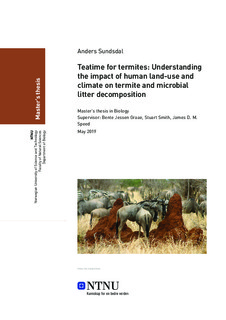| dc.description.abstract | Nedbrytning av planter er en fundamental underliggende prosess for næringssyklus og
økosystemproduktivitet. Nedbrytningshastigheten i savanneøkosystemene er avhengige av
både jordmikrober og makrofauna, hvor termitter er kjent for å være viktige. Det er imidlertid
lite kjent om hvordan balansen mellom disse nedbryterne påvirkes av et økende landskap
dominert av mennesker. Her tar vi tak i dette kunnskapshullet ved å undersøke mikrober og
termitters bidrag til nedbrytningsprosessen over tre savannelandbruk: landbruks-, kvegbruksog
Villmark-forvaltet område i og utenfor Serengeti Nasjonal Park, Tanzania. Vi brukte en
selektiv nett-metode til å sammenligne effekten av mikrobiell og termitt-drevet nedbrytning
ved å bruke globalt standardiserte substrater: lett nedbrytbart grønn te og sakte nedbrytbart
rooibos te, også kjent som Tea Bag Index. Teposene ble begravet i de forskjellige landbruks
områdene i to ulike regnregioner i løpet av regn- og tørkesesongen. I tillegg etablerte vi en
«common garden» for å vurdere hvordan jordforholdene påvirker nedbrytningen på tvers av
landbruk og regnregimer. Vi fant ut at mikrober bryter ned den lett nedbrytbare grønne teen i
langt høyere grad i den våte sesongen og i den våtregionen. I tillegg har termitter og andre
makrofauna liten eller ingen innvirkning av denne teen. I motsetning til dette ble nedbrytningen
av rooibos te sterkt påvirket av termitter, særlig resulterte dette i høyere nedbrytningsrate i tørr
sesong og i tørre områder enn mikrobers’ nedbryting av grønn te. Bidraget fra termittene og
annen makrofauna var størst i landbruks- og kvegområder sammenlignet med Villmarkforvaltet
område iløpet av tørkesesongen. Ved å bruke «common garden» fant vi ingen
påvirkning av jordegenskaper på nedbrytning. Disse funnene illustrerer betydningen av
termitter for en kontinuerlig næringssyklus i tørre savannemiljøer. | |
| dc.description.abstract | Plant litter decomposition is a fundamental process underlying nutrient cycling and ecosystem
productivity. Rates of decomposition in savannah ecosystems are dependent on both soil
microbes and macrofauna, where termites are known to be important. However, little is known
about how the balance between these decomposers is influenced by an increasing human
dominated landscape. Here, we address this knowledge gap by investigating the contribution
of microbes and termites to litter decomposition across three savannah land-uses: agricultural,
pastural and wildlife protected areas in and around the Serengeti National Park, Tanzania. We
used a selective mesh approach to contrast the impact of microbial and termite driven
decomposition on a global standard litter types: labile green tea and recalcitrant rooibos tea,
also known as the Tea Bag Index. Teabags were buried across the different land-uses in two
contrasting rainfall regions and during both wet and dry seasons. Additionally, we established
a common garden to assess how soil conditions influence the decomposition across land-uses
and rainfall regimes. Overall, we found that microbes decompose the labile green tea to a far
higher degree in the wet season and wet region, and that termites and other marofauna have
little to no impact of labile litter decomposition. In contrast, the decomposition of the
recalcitrant rooibos tea was strongly influenced by termites, in particular resulting in higher
rates of decomposition in dry season and dry regions than microbial labile litter decomposition.
Importantly, the contribution of termites and macrofauna was greatest in agricultural and
pastural areas compared to wildlife protected areas during dry season. Through the use of the
common garden we found no influence of soil properties on decomposition. These findings
illustrate the importance of termites for the continuous nutrient cycling during dryer savannah
conditions with an previously undervalued importance of macrofauna on human modified
savannah landscapes. | |
